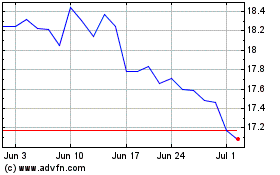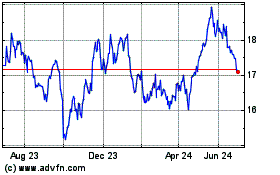Top regulator raises possibility of breakup in light of
wildfires; accountability faulted
By Russell Gold and Katherine Blunt
This article is being republished as part of our daily
reproduction of WSJ.com articles that also appeared in the U.S.
print edition of The Wall Street Journal (November 16, 2018).
A California regulator said late Thursday that it was expanding
a probe of PG&E Corp.'s safety practices to explore the way the
company is managed and run, including whether it should be broken
up.
"I will open a new phase examining the corporate governance,
structure, and operation of PG&E, including in light of the
recent wildfires, to determine the best path forward for Northern
Californians to receive safe electrical and gas service in the
future," Michael Picker, the president of the California Public
Utilities Commission, said in a statement.
Later, in an interview with The Wall Street Journal, he said was
concerned about how PG&E handled safety operations, including
its transmission lines that have sparked wildfires in recent years.
He said the company's decision to compensate its former chief
executive after PG&E was found negligent for a large 2010 gas
explosion that killed eight people as well as its failure to
replace its board "left us wondering is anyone ever accountable for
failing to provide safety at PG&E."
He added: "I am very concerned that they don't have
accountability in place."
He said his expanded review of the company could include whether
to break it up into smaller utilities. "We will put all these
things on the table," Mr. Picker said.
The commission had begun a review of whether PG&E's
"organizational culture and governance prioritize safety" in
2015.
Meanwhile, Moody's Investors Service on Thursday evening
downgraded the ratings of PG&E Corp.'s debt, as well as the
long-term ratings of the company's main utility subsidiary, Pacific
Gas & Electric Co, and said all of the ratings for both are on
review, which could result in a multi-notch ratings downgrade.
The developments capped a wild trading day in which shares of
PG&E fell for the sixth straight day, then rebounded in
after-hours trading, as investors grappled with the volatility that
now comes with owning California's largest utility.
PG&E shares fell more than 30% to close at $17.74 on
Thursday amid investor concerns that the utility, already facing
huge potential liability costs from 2017 wildfires, could be hit
with even more costs related to a current fire in Northern
California that has become the deadliest in state history, killing
more than 50 people.
But the shares then shot up and recovered after hours in a
roller-coaster ride for investors.
PG&E has disclosed that a problem occurred on one of its
high-voltage power lines in Northern California 15 minutes before
the start of the Camp Fire was reported in the area Nov. 8. No
definitive connection between the line outage and the fire has been
made, and California fire investigators will likely take months to
make a final determination.
"It's important to remember that the cause of the fire has not
been determined," PG&E spokeswoman Lynsey Paulo said in a
statement. "We will cooperate with any investigations, and support
the development of best practices and new policies to help prevent
wildfires and protect the public."
The company's stock has been on a downward trajectory over the
past six days as concerned investors confront yet another
fire-related risk for the company, which is already grappling with
more than 800 civil lawsuits from the 2017 fires. State
investigators have concluded that PG&E equipment helped spark
at least 16 of those fires last year.
PG&E said it "wasn't going to speculate or comment on what
factors may or may not be impacting the stock market."
"This is the new normal," said Michael Wara, head of the climate
and energy policy program at Stanford University's Woods Institute.
"Investors believe and are pricing in and acting as if PG&E
will lose a few billion every year because of wildfire
liability."
Equity analysts estimate PG&E could face more than $10
billion in lawsuits and fines from fires in 2017 and from the Camp
Fire this year. The company only has about $1.4 billion in
insurance coverage for fires and about $13.2 billion in annual
revenue from electricity sales.
Thursday's drop was the worst in the S&P 500, and the
preliminary trading volume was the highest on record for the
company. The steep fall in PG&E shares suggests investors
believe the company may be forced to file for bankruptcy
protection, a move that would almost certainly wipe out
shareholders.
The outlook for bond investors is more complicated. Many
PG&E bonds were trading at discounts to their par value,
indicating some concern about the company's prospects. But, in
general, the selling was less intense in the bond market, as many
bond investors expect the company to be able to largely pay its
debts regardless of what happens with wildfire-liability
claims.
The price of PG&E's most active issue, some $3 billion in
6.05% bonds which mature in 2034, gained more than 3 cents Thursday
to 92.5 cents on the dollar, according to MarketAxess. Other
PG&E bonds, which had been trading at distressed levels, also
saw gains. The company's 4% bonds due in 2046 were up almost 4
points to 77.25 cents on the dollar.
Earlier this week, PG&E drew down its full bank line of
credit, a move many analysts saw as a sign its access to debt and
equity markets might be limited. "It's unclear whether the company
will have access to the capital markets at this time," said Jeffrey
Cassella, an analyst with Moody's Investors Service.
Despite the uptick in its bond prices Thursday, PG&E Corp.,
the parent of the utility, will be shut out of the market for bonds
because it is now clear that highly destructive wildfires may be an
annual event, said Andrew DeVries, a high-yield bond analyst at
CreditSights. That raises the risk that lawsuits related to the
wildfires would become a regular occurrence, he added.
The company's financial situation has led to speculation that it
might need a bailout of some sort from the state of California. "As
the company's cash position diminishes, the risk of bankruptcy
could increase unless politicians intervene," wrote Mizuho
Securities USA LLC analyst Paul Fremont.
Earlier this year, California passed legislation that would
allow utilities to securitize wildfire liability by floating bonds
and passing on the costs to ratepayers under certain circumstances.
But the law takes effect in January, leaving utilities exposed to
liabilities that could occur as a result of fires in 2018.
Citi analyst Praful Mehta said the stock selloff reflects
investors' concerns that California might not act to help PG&E
offset potential liability costs arising this year if the move is
viewed as a bailout. "Politically, it could be very challenging,"
he said. "If the political will isn't there, the only way this
could get resolved is to push it into restructuring."
Utility stocks are usually seen as somewhat boring investments
that deliver predictable dividends. But PG&E has become a stock
without a dividend or the prospect of one for the foreseeable
future. The company cut the dividend earlier this year to preserve
cash in anticipation of mounting liability costs after the 2017
fires.
"It's usually considered a safe investment," said David Spence,
a professor who teaches energy law at the University of Texas,
referring to PG&E stock, "but it's not looking very safe right
now."
--Sam Goldfarb,
Patrick Thomas
and Soma Biswas contributed to this article.
Corrections & Amplifications An earlier version of this
article incorrectly referred to PG&E Corp. as PGE Corp. in one
instance. (Nov. 15, 2018)
Write to Russell Gold at russell.gold@wsj.com
(END) Dow Jones Newswires
November 16, 2018 02:47 ET (07:47 GMT)
Copyright (c) 2018 Dow Jones & Company, Inc.
PG&E (NYSE:PCG)
Historical Stock Chart
From Mar 2024 to Apr 2024

PG&E (NYSE:PCG)
Historical Stock Chart
From Apr 2023 to Apr 2024
